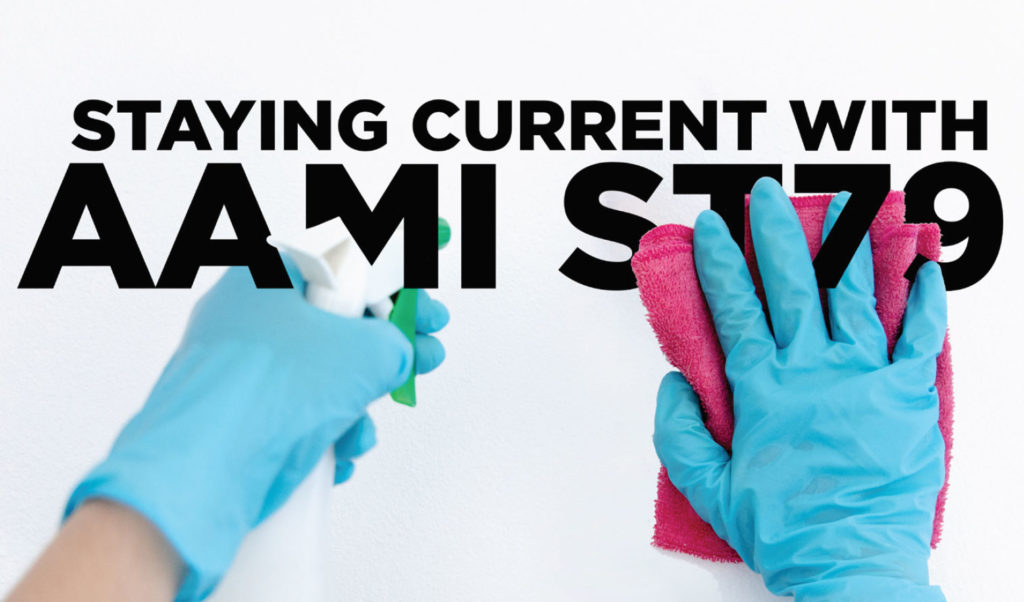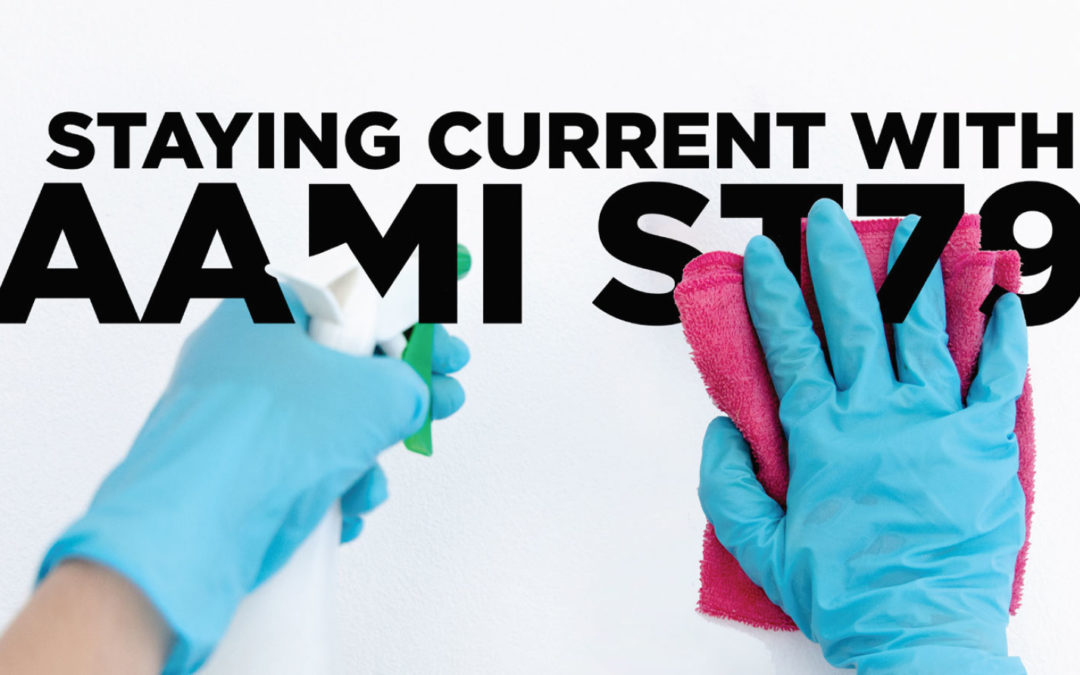
By Don Sadler
 In 2017, AAMI released a long-awaited update to the widely used steam sterilization standard for health care facilities that had previously been updated in 2010.
In 2017, AAMI released a long-awaited update to the widely used steam sterilization standard for health care facilities that had previously been updated in 2010.
Known as “ANSI/AAMI ST79, Comprehensive guide to steam sterilization and sterility assurance in health care facilities,” the standard provides comprehensive information on how to achieve sterilization in a health care facility. Soon after the updated standard was released, the Steam Sterilization Hospital Practices Working Group that updated the standard began receiving feedback and requests for clarification in key areas.
“The working group decided to initiate amendments to add the recommendations to the standard now rather than wait for the complete revision of the document,” says Susan Klacik, BS, FSC, ACE, CHL, CIS, CRCST, AAMIf, IAHCSMM clinical educator and co-chair of the working group.
“Users need this detailed information to fully support best practices in steam sterilization,” says Erin Kyle, DNP, RN, CNOR, NEA-BC, editor in chief, Guidelines for Perioperative Practice for the Association of periOperative Registered Nurses (AORN), who also serves on the working group.
“One of the great things about working with AAMI to develop and maintain sterilization standards is that the working group has the ability to make these updates when they are needed,” Kyle adds. “The documents are dynamic and the update process is agile enough to respond to requests for clarification and new knowledge when they arise.”
A Trusted Method
Steam sterilization is one of the oldest, safest and most common methods used in health care facilities, says Klacik. “Many people believe that because steam sterilization has been available for so many years, it’s a simple process that’s well understood and controlled.”
“However, the efficacy of any sterilization process depends on a consistent system for lowering and limiting bioburden before sterilization,” Klacik adds. “It also depends on preparing items for sterilization, selecting the sterilization parameters, and establishing and implementing controls to maintain the sterility of sterilized items until they are used.”
The steam sterilization working group spent one year collecting feedback from users about the 2017 ANSI/AAMI ST79 update and two years researching and developing the amendments. The result was the ANSI/AAMI ST79:2017’s 2020 amendments, which were released early this year.
These amendments offer new clarity and fresh guidance to maintain the integrity of the sterile processing area and help users stay in compliance with accrediting bodies.
“Having the most current editions of the standards is a must because reprocessing continues to change and evolve as procedures become more complex along with the devices that are released to the market,” says Delores O’Connell, LPN, BA, AGTS, ASQ-CQIA, CRCST, CIS, CER, CHL, CSPDT, senior clinical education specialist with Steris who previously served on the working group.
“The guidance from ANSI/AAMI ST79:2017 and the 2020 amendments addresses the process that should be followed alongside the specific manufacturer’s instructions for use (IFU),” O’Connell adds. “This is paramount to successful reprocessing of all reusable medical devices.”
ANSI/AAMI ST79 is an especially important standard because it provides comprehensive guidance to health care personnel who use steam for sterilization – regardless of the size of the sterilizer or type of facility. This includes hospitals, ASCs, physician offices, cardiac catherization labs, endoscopy suites, radiology departments and dental offices.
“The standard remains a go-to for The Joint Commission,” says Klacik. She calls writing a standard “a balancing act” because it covers such a broad swath of venues.
“But everyone also needs the right specifications,” she says. “Through AAMI, we have this wonderful collaborative community. We can collect everybody’s views in one place and really iron out what is working versus what isn’t.
What’s in the Amendments?
According to Klacik, the amendments contain even “common sense” additions like stipulating that there should be no food or drink in the sterile processing area. Other amendments were made to best practices, like how often sterilizers in health care facilities should be cleaned.
In addition, the working group built upon recommendations for the instrument inspection process. “We recognized that relatively new technologies like borescopes and Adenosine Triphosphate (ATP) monitoring enable more thorough inspections and recordkeeping,” says Klacik.
Here are the four amendments that were made to ANSI/AAMI ST:79:
Amendment 1: Additions were added to Section 3.2.1.1 General design considerations, Environmental Services/Fans/Food and Drink; and Section 3.3.5.5 Heating, Ventilation, and Air Conditioning (HVAC) Operating Parameters. “Both additions include new recommendations for maintaining the integrity of the sterile processing area,” says Klacik.
Amendment 2: Section 8, Inspection of Insulated Instruments, added two new sections. “New guidance in Section 8.2 addresses the general instrument inspection process,” says Klacik. “And a new section – 8.2.1 – addresses the inspection of insulated instruments intended for use with electrical current (otherwise known as electrosurgical instrumentation).”
Amendment 3: “Content was modified regarding the frequency of cleaning for sterilizers in sterile processing areas of health care facilities,” says Klacik. The changes can be found in Section 12.4, Routine Care of Sterilizers.
Amendment 4: Content was modified regarding the recording of biological indicator lot numbers in sterilizer records for sterile processing in health care facilities. “The changes better clarify the specific number to document when the biological monitor and control are recorded,” says Klacik.
One problem the amendments address from prior additions is that previously, directives were mixed with rationales.
“When technicians were attempting to align the operations in their facilities with the standards, they often felt the passages were confusing and sometimes even repetitive,” says O’Connell.
During the update for ANSI/AAMI ST79:2017, O’Connell says the working group paid very close attention to this feedback. “Now the directives are easily identified and illustrate what should occur during a specific portion of the process,” she says.
“The rationale following the directive provides additional information for circumstances where the reader may need clarification,” O’Connell adds. “Or it may highlight particular reprocessing considerations for specific processes and allow for a deeper understanding of the intent of the section.”
Methods of Instrument Cleaning
Klacik stresses the importance of thorough cleaning of the sterile processing environment, as detailed in Amendment 1. “Otherwise, dust and debris can contaminate the instrumentation,” she says. “Methods of cleaning to prevent the spread of dust and debris are discussed in the amendment – in particular, controlling items permitted in areas that process medical devices.”
Amendment 1 provides a few new recommendations to monitor the cleanliness of the sterile processing environment. “First, a cleaning schedule should be developed along with a checklist to demonstrate compliance and areas of focus,” says Klacik.
Kyle points out that a new sample housekeeping checklist is included in the amendments. “Sterile processing teams can easily monitor adherence to housekeeping procedures by using and monitoring checklists,” she says.
In addition, cleaning verification tools have been added to measure the adequacy of environmental cleaning. “These include ultraviolet light visible markers, protein tests and ATP bioluminescence, as well as direct observation of employees performing environmental cleaning,” says Klacik.
The amendments also include recommendations that only the ventilation system exhaust fans should be used and that neither fixed nor portable fans should be permitted in any area of sterile processing, Klacik adds.
“The HVAC system is a very important part of the environment since ventilation patterns and other environmental controls affect the proliferation and spread of potentially pathogenic microorganisms,” she says.
Meanwhile, Amendment 2 discusses the use of enhanced inspection. “This enables the technician to better visualize bioburden, foreign material or damage and prevent it from going unnoticed,” says Klacik.
Enhanced inspection is performed with the use of magnification, borescopes or other inspection methods to verify cleanliness and integrity. “Borescopes are a great tool for inspecting internal channels of instrumentation for cleanliness and integrity since the naked eye cannot see into these areas,” says Klacik
Dangers of Using Malfunctioning Equipment
According to Kyle, using a malfunctioning piece of equipment could result in harm to the patient – including burns that can go unrecognized. “This is especially true if they are outside the field of view during the procedure,” says Kyle.
“The electrical current can escape the instrument at the point where the insulation is damaged through capacitive coupling,” Kyle explains. “Burn injuries can be prevented by recognizing these defects before the instruments make it to the OR and are used for patient care.”
Smaller insulation breaches are especially problematic because they can concentrate the escaped energy and cause more serious tissue injury, says Klacik.
“Insulated electrical current instruments are susceptible to physical and mechanical damage and degradation with repeated use,” Klacik says. “These defects in insulation are not always visually detectible – some are only detectible by using insulation and continuity testing devices.”
Kyle says that during the revision of the AORN Guideline for Electrosurgical Safety last year, they found a study where researchers evaluated the electrical current leakage from robotic instruments with visually intact insulation.
“They found that all of the instruments had electrosurgical current leakage,” says Kyle. “This tells us that visual inspection for defects alone is not effective. Evaluation with an insulation tester is crucial to protect patients from burns due to capacitive coupling.”
The AORN Guideline for Electrosurgical Safety recommends the use of an active electrode monitoring and shielding device as an additional safeguard to prevent these burn injuries.
To help prevent this kind of damage to instruments, it’s recommended that instruments be organized and protected from damage through processing and use, says Klacik. “Organizing instrument trays can help here,” she says.
“Also, electrosurgical insulated instruments should be tested for integrity each time they are processed,” Klacik adds. “The insulation should be checked at appropriate inspection points for the instrument.”
Cables and cords are another source of concern. “These must be inspected and checked for integrity and continuity,” says Klacik.
“The amendment includes a table demonstrating the instrumentation inspection points and possible damage for various instruments and devices, as well as photos of insulated instruments with damaged insulation as a reference,” says Klacik.
Auditing Your Processes and Policies
Now that the amendments have been released, health care organizations should audit their processes, policies and daily operations for steam sterilization in light of them.
“Health care organizations are already monitoring quality in these areas,” says Kyle. “What they need to do in light of these amendments is to integrate these changes into their process by first integrating them into their policies and procedures.”
“Next, they should comprehensively educate members of the perioperative team about these changes,” Kyle adds. “This includes both sterile processing personnel and clinicians who work in the operating room. These two things really need to happen simultaneously.”
The amended document is available through AAMI at aami.org/ST79. “ANSI/AAMI ST79, Comprehensive guide to steam sterilization and sterility assurance in health care facilities” will be automatically updated for users with an AAMI eSubscription.
If you previously purchased the printed version or who have a PDF of the current edition, you should have received a PDF of the amendments at no charge. If you haven’t received one, send an email to customerservice@aami.org.
If you don’t have a current edition of the standard, you can purchase one with the amendments included from the AAMI store at aami.org.
For more information about the AORN Go Clear program, visit https://www.aorn.org/member_apps/Product/Detail?productID=9709.









